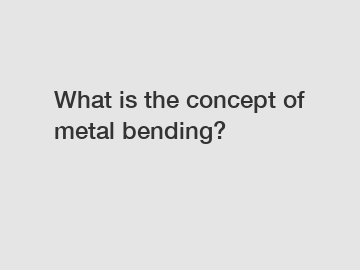Feb. 06, 2024
Tools
What is the Concept of Metal Bending?
Metal bending, a fascinating technique with a long history, is the art of manipulating metal objects to reshape them into different forms or angles. This process involves applying heat or force to the metal, transforming it into a desired shape. Whether it is used in industries like construction or as a creative expression in metal artwork, metal bending has become an essential skill. Let's dive into the concept of metal bending, exploring its various techniques and applications.
Point 1: The Basics of Metal Bending.

Metal bending involves altering the shape of metal objects without causing any damage to their overall structure. By applying controlled pressure or heat, it is possible to bend metals like steel, copper, aluminum, and many others. Traditional metal bending methods involve the use of hammers, anvils, and molds, allowing craftsmen to create precise curves or angles. However, modern techniques, such as hydraulic presses and computer-controlled machines, have simplified the process significantly.
Point 2: Techniques and Tools.
Several techniques and tools are employed for metal bending, depending on the object's complexity and the desired outcome. Let's explore three commonly used methods:
1. Press Brake Bending: This technique involves using a press brake machine to bend metal sheets or plates. The metal is placed on a V-shaped die, and a punch is used to press down and bend it to the desired angle. This technique is widely used in the manufacturing industry to create components for various applications, including automobile parts and structural elements.
2. Roll Bending: Roll bending is primarily used to create curved or circular shapes with long metal sheets or bars. This technique employs three rollers, with two driving rolls and one idler roll, to gradually bend the metal into the desired curvature. Roll bending is commonly seen in industries like shipbuilding, HVAC systems, and manufacturing of pipes or tubes.
3. Hot Bending: Hot bending involves heating the metal to a specific temperature and then bending it. This method is predominantly used with steel or other alloys that require high temperatures for malleability. By applying heat, the metal becomes more flexible, allowing craftsmen to bend it to their desired shape. Hot bending can be done manually using torches or through automated induction heating machines.
Point 3: Applications of Metal Bending.
Metal bending finds applications in various industries and fields, showcasing its versatility and importance. Here are a few notable areas where metal bending plays a crucial role:
1. Construction: In the construction industry, metal bending is essential for creating architectural structures, such as curved staircases, railings, and steel beams. By bending metal components, builders can achieve both functional and aesthetically appealing designs.
2. Automotive and Aerospace: The manufacturing of automobile and aircraft components heavily relies on metal bending. From exhaust systems to fuselages, metal bending ensures the production of durable and efficient parts that meet strict safety standards.
3. Art and Design: Metal bending is also a popular technique in the world of art and design. Artists and sculptors use metal bending to create intricate and captivating pieces, pushing the boundaries of creativity. Whether it is a large-scale metallic installation or a delicate jewelry piece, metal bending adds a unique touch to artistic expression.
Point 4: Advancements and Future Possibilities.
With technological advancements and continuous research, the art of metal bending is evolving rapidly. Automation, robotics, and computer-aided design have revolutionized the industry, making metal bending processes more efficient, precise, and accessible. Moreover, the development of new alloys and materials provides exciting opportunities for further exploration and innovation in the field of metal bending.
Conclusion:
In conclusion, the concept of metal bending encompasses a broad range of techniques and applications. From basic manual bending to advanced computer-controlled processes, metal bending allows us to reshape and mold metals to achieve desired forms. Whether it is seen in towering skyscrapers or delicate sculptures, metal bending showcases the human ability to transform and manipulate one of the most robust materials known to us. As technology progresses, the future of metal bending holds great potential for even more remarkable creations.
The company is the world’s best aluminum sheet bending machine, press brake supplier, metal roof sheet bending machine supplier. We are your one-stop shop for all needs. Our staff are highly-specialized and will help you find the product you need.
Previous: What is the purpose of a gas booster?
Next: Stay Safe with Non-Sparking Tool Kits: Your Essential Guide to Fire Prevention
If you are interested in sending in a Guest Blogger Submission,welcome to write for us!
All Comments ( 0 )